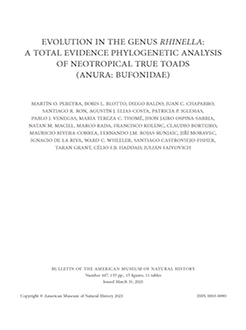True toads of the genus Rhinella are among the most common and diverse group of Neotropical anurans. These toads are widely distributed throughout South America, inhabiting a great diversity of environments and ecoregions. Currently, however, the genus is defined solely on the basis of molecular characters, and it lacks a proper diagnosis. Although some phenetic species groups have traditionally been recognized within Rhinella, the monophyly of some of them have been rejected in previous phylogenetic analyses, and many species remain unassigned to these poorly defined groups. Additionally, the identity and taxonomy of several species are problematic and hinder the specific recognition and description of undescribed taxa. In this work, we first perform phylogenetic analyses of separate mitochondrial and nuclear datasets to test the possible occurrence of hybridization and/or genetic introgression in the genus. The comparative analysis of both datasets revealed unidirectional mitochondrial introgressions of an unknown parental species into R. horribilis (“ghost introgression”) and of R. dorbignyi into R. bernardoi; therefore, the mitochondrial and nuclear datasets of these species were considered separately in subsequent analyses. We performed total-evidence phylogenetic analyses that included revised molecular (four mitochondrial and five nuclear genes) and phenotypic (90 characters) datasets for 83 nominal species of Rhinella, plus several undescribed and problematic species and multiple outgroups. Results demonstrate that Rhinella was nonmonophyletic due to the position of R. ceratophrys, which was recovered as the sister taxon of Rhaebo nasicus with strong support. Among our outgroups, the strongly supported Anaxyrus + Incilius is the sister clade of all other species of Rhinella. Once R. ceratophrys is excluded, the genus Rhinella is monophyletic, well supported, and composed of two major clades. One of these is moderately supported and includes species of the former R. spinulosa Group (including R. gallardoi); the monophyletic R. granulosa, R. crucifer, and R. marina Groups; and a clade composed of the mitochondrial sequences of R. horribilis. The other major clade is strongly supported and composed of all the species from the non-monophyletic R. veraguensis and R. margaritifera Groups, the former R. acrolopha Group, and R. sternosignata. Consistent with these results, we define eight species groups of Rhinella that are mostly diagnosed by phenotypic synapomorphies in addition to a combination of morphological character states. Rhinella sternosignata is the only species that remains unassigned to any group. We also synonymize nine species, treat three former subspecies as full species, and suggest that 15 lineages represent putative undescribed species. Lastly, we discuss the apparently frequent occurrence of hybridization, deep mitochondrial divergence, and “ghost introgression”; the incomplete phenotypic evidence (including putative character systems that could be used for future phylogenetic analyses); and the validity of the known fossil record of Rhinella as a source of calibration points for divergence dating analyses.
How to translate text using browser tools
31 March 2021
Evolution in the Genus Rhinella: A Total Evidence Phylogenetic Analysis of Neotropical True Toads (Anura: Bufonidae)
Martín O. Pereyra,
Boris L. Blotto,
Diego Baldo,
Juan C. Chaparro,
Santiago R. Ron,
Agustín J. Elias-Costa,
Patricia P. Iglesias,
Pablo J. Venegas,
Maria Tereza C. Thomé,
Jhon Jairo Ospina-Sarria,
Natan M. Maciel,
Marco Rada,
Francisco Kolenc,
Claudio Borteiro,
Mauricio Rivera-Correa,
Fernando J.M. Rojas-Runjaic,
Jiří Moravec,
Ignacio De La Riva,
Ward C. Wheeler,
Santiago Castroviejo-Fisher,
Taran Grant,
Célio F.B. Haddad,
Julián Faivovich






